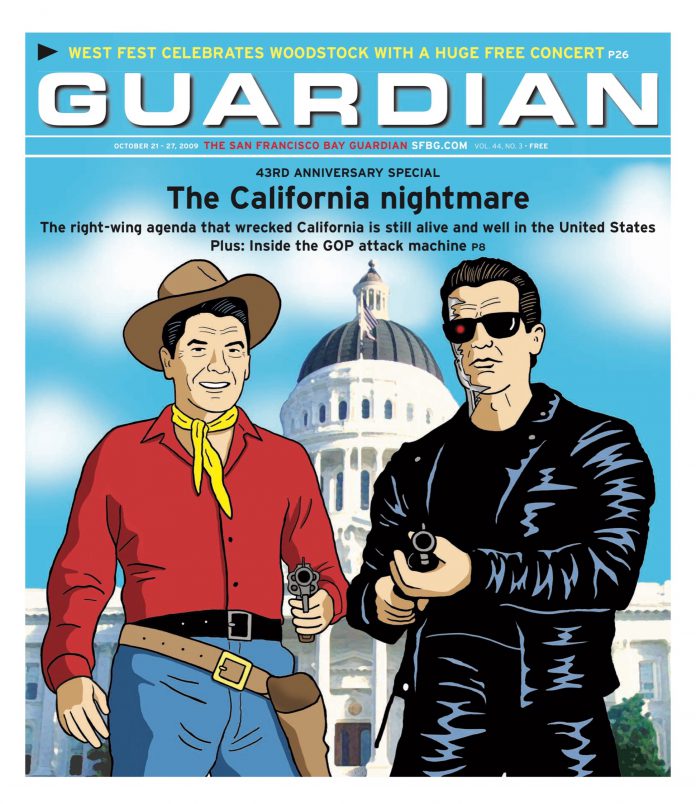arts@sfbg.com
MUSIC In Guitar Hero 5, the avatar of Kurt Cobain is wearing a tee adorned with the cover of Daniel Johnston’s 1983 album, Hi, How Are You? (High Wire). The t-shirt presents a pop-eyed frog, Jeremiah the Innocent, one of the recurring characters within Johnston’s creative world.
Cobain helped catapult many musical cult heroes, among them the Melvins and the Raincoats, to new notoriety, and his devotion to Johnston was no exception. Although it’s hard to pinpoint which moment transformed Johnston into a somebody — K Records selling his homemade cassettes? his serendipitous MTV appearance? Cobain’s adoration? Jeff Feuerzeig’s 2005 documentary The Devil and Daniel Johnston? — most Daniel Johnston stories are part of a narrative that defines him as an unstable artistic genius.
Johnston was born in 1961 to a Christian fundamentalist household in Sacramento. In the early 1980s, he spent most of his time in his parents’ cellar, writing songs. He recorded his seminal cassettes on a Sanyo mono boom-box. After a corndog-selling gig with a traveling circus, he eventually found himself — and went on to lose himself — in Austin, Texas. There, his popularity as a musician grew as his mental stability declined.
Johnston’s story has more twists than most — he’s been institutionalized multiple times, crashed a small plane his father was piloting, and contributed artwork to the 2006 Whitney Biennial. But in Fuerzeig’s documentary, Johnston’s odyssey ends where it began, with him making art at his parents’ home.
In the process of "growing up," most people put away the piano, the paintbrushes, and pen-and-paper in exchange for something practical. When contemputf8g the artist who never gives in to societal obligations, it isn’t uncommon to entertain the notion that creativity springs from craziness.
Some scientific evidence supports a link between creativity and bipolar disorder. Clinical psychologist Kay Redfield Jamison’s 1993 book Touched With Fire: Manic-Depressive Illness and the Artistic Temperament explains that during a manic phase, there is often a "fluency, rapidity, and flexibility of thought … and the ability to combine ideas or categories of thought in order to form new and original connection." Ideas often occur during the manic phase. During the artist’s melancholic periods, there is a refinement of such thoughts, requiring a more logical perspective to put the new ideas into practice.
Jamison discusses artists’ resistance to undergoing drug therapy — who would want to give up the highs and lows for mild numbness? In The Devil and Daniel Johnston, Johnston spends 1987 in bed on meds, and it does appear dismal. But Jamison advocates that untreated bipolar disorder may lead to suicide.
"All great artists are crazy," Austin Chronicle editor Louis Black says in The Devil and Daniel Johnston. "But there is a difference between the abstract creative person being crazy and this person doing damage to you or himself." Black questions how we, as individuals and as a society, should deal with the mentally ill. If we drug or institutionalize the crazy artist, who benefits: the individual, the friends and family, the fans — or art history? And which is most important?
If there are answers or solutions to such questions, they doesn’t reside in rotely accepting a cultural myth or a scientifically provable connection between creativity and craziness. First it helps to realize that there is a continuum between the "healthy" and the "mentally ill." Indeed, the collective understanding of what is sane and what is insane needs reevaluation. Many people live with psychotic traits but no debilitating symptoms. Each of us who has found comfort or a moment of recognition in Johnston’s lyrics has probably felt a tinge of what might be deemed mental illness.
With a distinctive quavering voice, Johnston sings tormented lyrics about universal themes — unrequited love and not giving up on your dreams — over ebullient and charming pop melodies. His music possesses a combination of craft and sincerity that appeals to the most basic human emotions. He is an oddball phenomenon whose biography provides clues to how the creative mind works. Amid all the chaos and the pain, Johnston continues on — with and without drugs, and definitely with the assistance of his family. His music, art, and life reflect a dichotomy between good vs. evil, hope vs. despair, and genius vs. madman. In the end, as captured in his most recent release Is and Always Was (High Wire), the good wins.
DANIEL JOHNSTON
with Hymns
Thurs/22, 8 p.m., $22.50–$25
Regency Ballroom
1290 Sutter, SF

